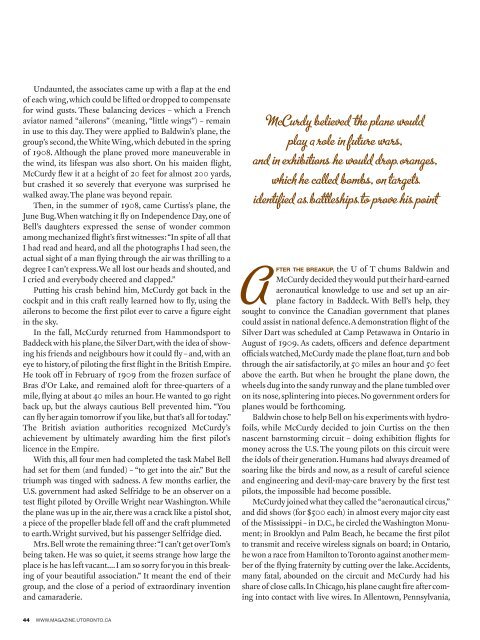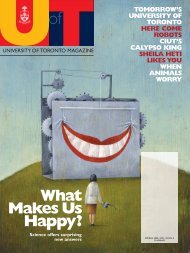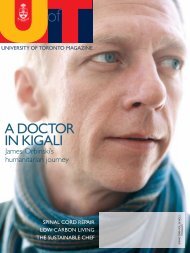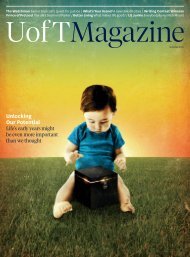The Next Big Idea 10 concepts that could - University of Toronto ...
The Next Big Idea 10 concepts that could - University of Toronto ...
The Next Big Idea 10 concepts that could - University of Toronto ...
Create successful ePaper yourself
Turn your PDF publications into a flip-book with our unique Google optimized e-Paper software.
Undaunted, the associates came up with a flap at the end<br />
<strong>of</strong> each wing, which <strong>could</strong> be lifted or dropped to compensate<br />
for wind gusts. <strong>The</strong>se balancing devices – which a French<br />
aviator named “ailerons” (meaning, “little wings”) – remain<br />
in use to this day. <strong>The</strong>y were applied to Baldwin’s plane, the<br />
group’s second, the White Wing, which debuted in the spring<br />
<strong>of</strong> 1908. Although the plane proved more maneuverable in<br />
the wind, its lifespan was also short. On his maiden flight,<br />
McCurdy flew it at a height <strong>of</strong> 20 feet for almost 200 yards,<br />
but crashed it so severely <strong>that</strong> everyone was surprised he<br />
walked away. <strong>The</strong> plane was beyond repair.<br />
<strong>The</strong>n, in the summer <strong>of</strong> 1908, came Curtiss’s plane, the<br />
June Bug. When watching it fly on Independence Day, one <strong>of</strong><br />
Bell’s daughters expressed the sense <strong>of</strong> wonder common<br />
among mechanized flight’s first witnesses: “In spite <strong>of</strong> all <strong>that</strong><br />
I had read and heard, and all the photographs I had seen, the<br />
actual sight <strong>of</strong> a man flying through the air was thrilling to a<br />
degree I can’t express. We all lost our heads and shouted, and<br />
I cried and everybody cheered and clapped.”<br />
Putting his crash behind him, McCurdy got back in the<br />
cockpit and in this craft really learned how to fly, using the<br />
ailerons to become the first pilot ever to carve a figure eight<br />
in the sky.<br />
In the fall, McCurdy returned from Hammondsport to<br />
Baddeck with his plane, the Silver Dart, with the idea <strong>of</strong> showing<br />
his friends and neighbours how it <strong>could</strong> fly – and, with an<br />
eye to history, <strong>of</strong> piloting the first flight in the British Empire.<br />
He took <strong>of</strong>f in February <strong>of</strong> 1909 from the frozen surface <strong>of</strong><br />
Bras d’Or Lake, and remained al<strong>of</strong>t for three-quarters <strong>of</strong> a<br />
mile, flying at about 40 miles an hour. He wanted to go right<br />
back up, but the always cautious Bell prevented him. “You<br />
can fly her again tomorrow if you like, but <strong>that</strong>’s all for today.”<br />
<strong>The</strong> British aviation authorities recognized McCurdy’s<br />
achievement by ultimately awarding him the first pilot’s<br />
licence in the Empire.<br />
With this, all four men had completed the task Mabel Bell<br />
had set for them (and funded) – “to get into the air.” But the<br />
triumph was tinged with sadness. A few months earlier, the<br />
U.S. government had asked Selfridge to be an observer on a<br />
test flight piloted by Orville Wright near Washington. While<br />
the plane was up in the air, there was a crack like a pistol shot,<br />
a piece <strong>of</strong> the propeller blade fell <strong>of</strong>f and the craft plummeted<br />
to earth. Wright survived, but his passenger Selfridge died.<br />
Mrs. Bell wrote the remaining three: “I can’t get over Tom’s<br />
being taken. He was so quiet, it seems strange how large the<br />
place is he has left vacant.... I am so sorry for you in this breaking<br />
<strong>of</strong> your beautiful association.” It meant the end <strong>of</strong> their<br />
group, and the close <strong>of</strong> a period <strong>of</strong> extraordinary invention<br />
and camaraderie.<br />
McCurdy believed the plane would<br />
play a role in future war,<br />
and in exhibition he would drop orange,<br />
which he called bomb, on targets<br />
identified as battleships to prove his point<br />
A<br />
fter<br />
the breakup, the U <strong>of</strong> T chums Baldwin and<br />
McCurdy decided they would put their hard-earned<br />
aeronautical knowledge to use and set up an airplane<br />
factory in Baddeck. With Bell’s help, they<br />
sought to convince the Canadian government <strong>that</strong> planes<br />
<strong>could</strong> assist in national defence. A demonstration flight <strong>of</strong> the<br />
Silver Dart was scheduled at Camp Petawawa in Ontario in<br />
August <strong>of</strong> 1909. As cadets, <strong>of</strong>ficers and defence department<br />
<strong>of</strong>ficials watched, McCurdy made the plane float, turn and bob<br />
through the air satisfactorily, at 50 miles an hour and 50 feet<br />
above the earth. But when he brought the plane down, the<br />
wheels dug into the sandy runway and the plane tumbled over<br />
on its nose, splintering into pieces. No government orders for<br />
planes would be forthcoming.<br />
Baldwin chose to help Bell on his experiments with hydr<strong>of</strong>oils,<br />
while McCurdy decided to join Curtiss on the then<br />
nascent barnstorming circuit – doing exhibition flights for<br />
money across the U.S. <strong>The</strong> young pilots on this circuit were<br />
the idols <strong>of</strong> their generation. Humans had always dreamed <strong>of</strong><br />
soaring like the birds and now, as a result <strong>of</strong> careful science<br />
and engineering and devil-may-care bravery by the first test<br />
pilots, the impossible had become possible.<br />
McCurdy joined what they called the “aeronautical circus,”<br />
and did shows (for $500 each) in almost every major city east<br />
<strong>of</strong> the Mississippi – in D.C., he circled the Washington Monument;<br />
in Brooklyn and Palm Beach, he became the first pilot<br />
to transmit and receive wireless signals on board; in Ontario,<br />
he won a race from Hamilton to <strong>Toronto</strong> against another member<br />
<strong>of</strong> the flying fraternity by cutting over the lake. Accidents,<br />
many fatal, abounded on the circuit and McCurdy had his<br />
share <strong>of</strong> close calls. In Chicago, his plane caught fire after coming<br />
into contact with live wires. In Allentown, Pennsylvania,<br />
44 WWW.MAGAZINE.UTORONTO.CA
















